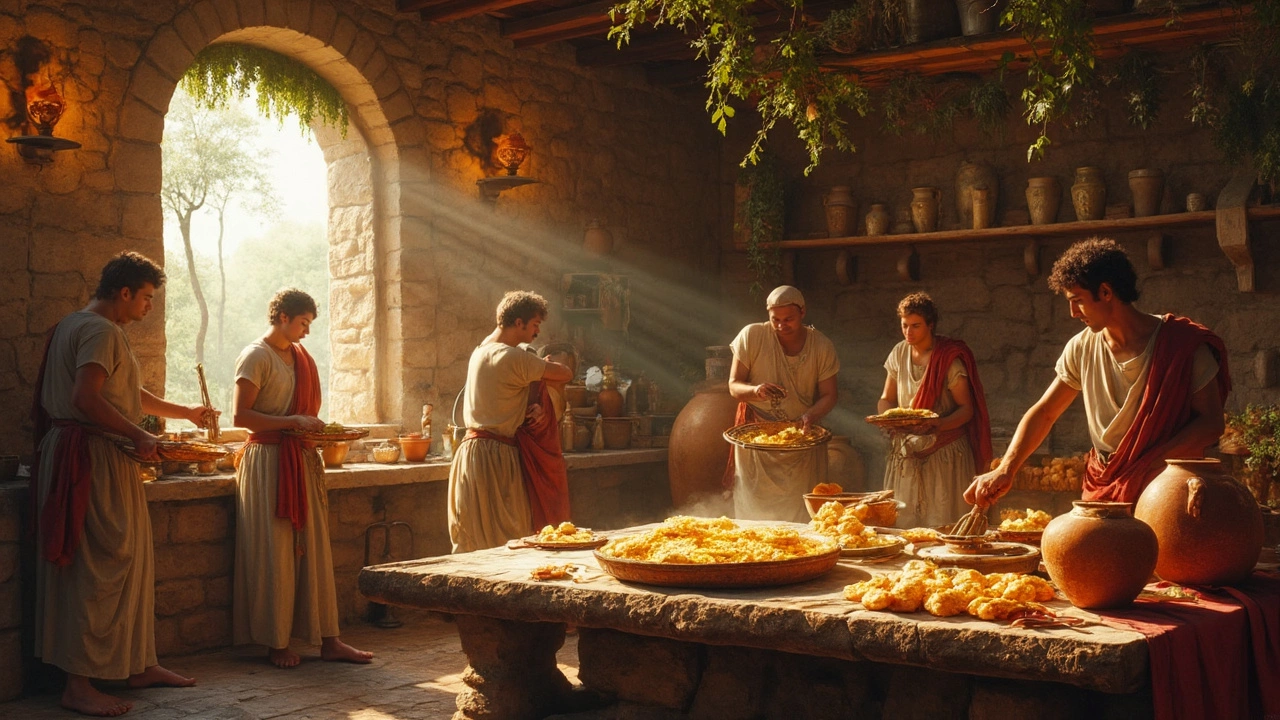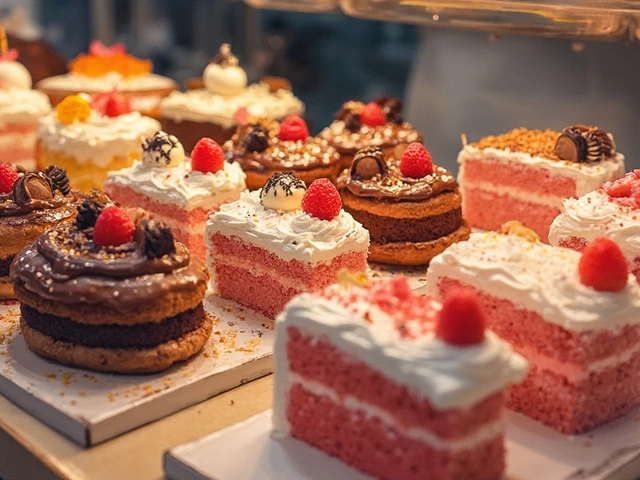
Ever thought about where our beloved cookies come from? Let's travel back in time and explore some of the earliest cookies that shaped the way we bake today. These aren't just any cookies; they're the ones that have been passed down through centuries, each bite carrying a story.
Starting off with the Romans' sweet indulgence—Libum, a cheesecake-like treat that was a hit at parties and religious offerings. Simple, yet oh-so-tasty, this ancient cookie was made with just a handful of ingredients, showing that sometimes less is more.
Then, there's the traditional mooncake from China, usually filled with a sweet or savory paste. These were not just cookies but part of a tradition celebrated during the Mid-Autumn Festival, marking the time to admire the full moon and its symbolism of unity.
- The Roman Sweet Tooth: Libum
- China’s Pioneers: Mooncakes
- Persian Delights: Ghraybeh
- Medieval Treats: Gingerbread
- Modern Takes on Ancient Flavors
- Baking Tips for Ancient Cookies
The Roman Sweet Tooth: Libum
Let's dive into the world of ancient Rome and uncover the secrets of Libum, a delightful treat that the Romans couldn't get enough of. Libum wasn't just a cookie—it was an ancestor to our modern cheesecake, often used in religious offerings, highlighting its significance in Roman society.
Libum was primarily made of cheese, honey, and flour. These simple ingredients were mixed to create a soft, sweet cake that was often offered to household gods or enjoyed at feasts. The ancient Roman cookbook 'De Agricultura' by Cato the Elder even included a recipe for this cherished treat, emphasizing its cultural importance.
Recipe for the Ages
Want to try your hand at making this ancient cookie? Here's a simplified version of the original Libum recipe:
- Take 3/4 cup of fresh ricotta cheese and drain it thoroughly.
- Mix it with 1/2 cup of all-purpose flour until smooth.
- Add in a tablespoon of honey for natural sweetness.
- Mold the mix into small cakes and place them on bay leaves.
- Bake the cakes at 350°F (175°C) for about 30 minutes until golden brown.
The resulting Libum is dense but delicious, and it’s amazing to taste something that’s connected to history so vividly!
An Ancient Tradition with Modern Appeal
Despite being centuries old, Libum still resonates today. Many home bakers love it for its simplicity and the rich flavors of cheese and honey. It's a brilliant example of how using just a few ingredients can result in something undeniably satisfying.
So, next time you're yearning for a sweet baking project, why not try this ancient cookie that’s as easy as pie to whip up? Not only will you enjoy a delicious treat, but you'll also savor a taste of history right in your own kitchen.
China’s Pioneers: Mooncakes
Mooncakes are not just ancient cookies; they're a testament to Chinese culture and tradition. These round pastries have been a staple of the Mid-Autumn Festival for centuries, a time when families come together to celebrate the harvest, the full moon, and unity. But what makes these cookies so special?
Traditionally, mooncakes are filled with sweet bean paste, lotus seed paste, or sometimes savory ingredients like salted egg yolks. The variety of fillings reflects the diverse tastes across different regions of China. These tasty treats symbolize completeness and reunion, a reason why they're often shared among friends and family.
History and Evolution
Mooncakes date back over 1,000 years, first appearing during the Tang dynasty. Back then, they were more than just a food item—they were used as a way to pass messages during the Yuan dynasty, helping organize a revolution against Mongol rulers. A creative blend of food and history!
Making Mooncakes at Home
- Start with a dough made from flour, sugar, and oil. The texture should be smooth yet firm enough to hold the filling.
- Prepare the filling of your choice. Lotus seed paste is the most traditional, but feel free to experiment with red bean paste or even a modern twist with chocolate.
- Shape the dough into small balls, then flatten them and wrap around the filling. The key is to ensure the dough evenly coats the filling inside.
- Use a mooncake mold to imprint designs on the surface. This gives it the iconic look we're familiar with.
- Bake until golden brown, and enjoy the fruit of your labor with loved ones during the next Mid-Autumn Festival.
Interesting Facts and Tips
The average mooncake contains about 1,000 calories, so they're meant to be shared and savored in small portions. They can be stored for weeks or even months, making them a perfect gift during festival times.
| Year | Event |
|---|---|
| 618-907 AD | Introduction during the Tang Dynasty |
| 1271-1368 AD | Used to organize a revolution against Mongols |
Whether you're a fan of sweet or savory, mooncakes offer a unique taste of history. Next time you're at a festival—or just in your kitchen—consider trying your hand at these delicious, iconic homemade cookies.
Persian Delights: Ghraybeh
When you think of ancient cookies, Ghraybeh might not be the first thing that comes to mind, but it should be on your list! It's a deliciously simple and buttery sensation from the Persian lands, often enjoyed during special occasions like weddings and festive gatherings.
Ghraybeh is renowned for its melt-in-your-mouth texture. What makes this cookie unique is its minimalistic ingredient list: flour, sugar, butter, and a hint of flavor, usually from rose or orange blossom water. This simplicity elevates the cookie's natural flavors, making it a beloved treat for centuries.
The Recipe Essentials
Intrigued? You might want to give these delightful cookies a go yourself. Here's what you'll need:
- 1 cup unsalted butter
- 1 cup powdered sugar
- 2 cups all-purpose flour
- A few drops of rose or orange blossom water
And here’s how you can whip them up:
- Cream the butter and sugar: Mix them until light and fluffy.
- Gradually add flour: Mix until the dough comes together. Add a little rose water for a lovely aroma.
- Shape the cookies: Form small balls and flatten slightly. You can press a pistachio in the center for a traditional touch.
- Bake: Place on a baking sheet and bake in a preheated oven at 350°F (175°C) for about 15 minutes, or until the edges are just starting to brown.
These cookies are perfect for sharing over a cup of tea, evoking a sense of tradition and warmth. Plus, with their crumbly texture and subtle aromatic hint, Ghraybeh remains a staple that transcends time, bringing a piece of Persian culinary history to your home.

Medieval Treats: Gingerbread
Gingerbread—a name that sparks the comforting image of winter spices and the tantalizing smell of baked goodness wafting through your home. This ancient cookie has been delighting taste buds since the medieval era, right around the late 11th century. It was then introduced in Europe, likely via the crusaders who had experienced spicy delights in the Middle East.
Gingerbread in medieval times wasn't quite like the cute little men and houses we see today. It was more of a hardened bread-like concoction, often sweetened with honey rather than sugar since sugar was a luxury. The spices like ginger, cloves, and cinnamon were indulgent, used by the wealthy and at special gatherings.
How It Changed Over Time
As trade routes expanded, the availability of spices and sugar increased, making gingerbread more accessible and diverse in its forms. It’s interesting to note that gingerbread's popularity soared in the medieval markets of France and Germany, where it was often pressed into molds depicting religious icons or important figures, which later led to the creation of elaborate gingerbread figures.
Making Medieval Gingerbread at Home
If you're keen to experience homemade cookies with an ancient twist, here's a simple recipe inspired by traditional methods:
- Mix 1 cup of honey, 2 teaspoons ground ginger, and 1 teaspoon cinnamon in a saucepan. Simmer until well combined.
- Add 3 and 1/2 cups of flour slowly, stirring until a thick dough forms.
- Roll out the dough on a floured surface to about 1/4 inch thickness and cut into shapes.
- Bake at 300°F (150°C) for about 15-20 minutes or until just firm.
Remember, baking history is as much about experience as it is about taste. Look out for intricate gingerbread fairs held annually in some European cities that still celebrate this lovely tradition!
Whether as a history lesson or simply as a treat with friends and family, medieval gingerbread is a delightful way to connect with culinary traditions that have shaped our sweets today.
Modern Takes on Ancient Flavors
Cookies have come a long way since ancient times, but what's fascinating is how these ancient cookies have thrived in modern kitchens. With a bit of creativity, classic recipes like Roman Libum and Chinese Mooncakes can transform into trendy treats without losing their historical charm.
Libum with a Twist
Want to jazz up the traditional Libum? Try adding a touch of honey or lemon zest to the dough. Many bakers today are experimenting with different cheese varieties, from goat cheese to ricotta, giving this homemade cookie a deliciously tangy kick.
Mooncakes for the Modern Palette
Though mooncakes remain a staple during the Mid-Autumn Festival, contemporary versions aren’t shy from mixing things up. Chocolate, matcha, and even ice cream fillings are now common. Plus, the outer pastry gets colorful makeovers, making these cookies not only tasty but also Instagrammable.
Ghraybeh Goes Global
The crumbly Persian delight, Ghraybeh, is traditionally flavored with cardamom or rose water. In today's kitchen, bakers might infuse vanilla or swap in pistachios for a bit of a crunch, making it a hit worldwide.
Gingerbread’s Glorious Evolution
The classic Gingerbread isn’t just for the holiday season anymore. Creative versions incorporate everything from spices like cayenne and citrus zest, to shifting gingerbread into unique shapes like dinosaurs or spaceships. Why not throw on a coat of almond glaze or dip them in white chocolate for an extra touch?
These tweaks and twists to timeless treats show that while we respect tradition, there’s always room for innovation. So, go ahead and experiment with these ancient cookies. Who knows, you might just create the next big hit for cookie lovers everywhere!
Baking Tips for Ancient Cookies
If you're eager to bring a taste of history into your kitchen, baking these ancient cookies is a must-try. The secret to getting it right lies in understanding the basics of each recipe's unique methods and ingredients.
Choosing the Right Ingredients
First thing first, ancient recipes use simple yet wholesome ingredients. For most of these cookies, ingredients like honey (used as a sweetener), nuts, and spices were common. Try sourcing fresh, raw honey and high-quality nuts to get that authentic taste.
Mastering the Techniques
Libum, for example, might look like a simple cheese bread, but it needs special attention. The Romans typically baked it on a hearth stone, a technique that can be mimicked using a pizza stone in your oven, ensuring an even heat distribution.
Adjusting to Modern Palates
While sticking to the original recipes can be rewarding, don’t shy away from tweaking them to suit modern tastes. Adding vanilla extract or a pinch of salt can accentuate the flavors, making them more relatable to today's cookie lovers.
Perfecting the Texture
The texture of these ancient cookies varies greatly. Mooncakes should have a firm yet tender bite, while Ghraybeh are melt-in-the-mouth. Watch your oven temperature and don’t rush the cooling process to achieve the ideal texture.
Storage Tips
Homemade cookies like these need proper storage to maintain freshness. Store them in an airtight container and consider adding a slice of bread to prevent them from drying out.
Here's a quick comparison of basic ingredient ratios for these cookies:
| Cookie | Main Ingredients | Sweeteners |
|---|---|---|
| Libum | Cheese, flour | Honey |
| Mooncakes | Flour, paste (lotus seed/bean) | Sugar |
| Ghraybeh | Flour, butter | Sugar |
By following these tips, you're not just baking cookies—you're preserving a piece of history. So, roll up those sleeves and enjoy bringing ancient times to your kitchen with these delightful homemade cookies.





